Digital Collections
Celebrating the breadth and depth of Hawaiian knowledge. Amplifying Pacific voices of resiliency and hope. Recording the wisdom of past and present to help shape our future.
Nanea Armstrong-Wassel [Ho‘okahua]
In the early 1880s, Charles Reed Bishop promised Princess Pauahi and Queen Emma that he would build a museum to preserve and exhibit the heirlooms that they had inherited from their chiefly ancestors. On December 2, 1887, the Bernice Pauahi Bishop Estate Board of Trustees granted him permission to build a fireproof, lava stone building on the grounds of the Kamehameha School for Boys at Kaiwi‘ula, which he named in honor of his wife, Pauahi.
It was Mr. Bishop’s desire, in locating the Museum on these premises, to perpetuate what of public interest, of national [Hawaiian Kingdom] interest, there is in this extensive and unique collection of Hawaiian antiquities and relics. Heredity and environment are two potent factors in the development of races and individuals. It is Mr. Bishop’s desire that these memorials of the past shall furnish suitable instruction and intensify patriotic enthusiasm in the Hawaiian youth of both sexes brought into these buildings, under these influences, for education and training, and, as such, they properly form a part of the equipment of these schools.
Rev. Charles McEwen Hyde, Founder’s Day Address, 1894
Mr. Bishop viewed the close proximity of the future museum to the Boys’ School as an integral part of the museum’s mission and the education of these upcoming leaders of Hawaiʻi.
Museums in Hawaiʻi were not novel to this time period. The act of curation firmly took root during the reign of Lot Kapuāiwa, Kamehameha V, through his establishment of a Hawaiian national museum. With the support of the Kingdom legislature, the King signed into law “An Act to Establish a National Museum of Archaeology, Literature, Botany, Geology, and Natural History of the Hawaiian Islands” on July 29, 1872. The preamble to the act expresses the proposed institution’s charge:
Whereas, we as a nation, have taken our position among the civilized and enlightened nations of the earth, both in respect to capabilities in self-government and in the facilities as we enjoy in our high and common schools in the diffusion of popular intelligence; and whereas, a national museum representing the archaeology, literature, geology, and national history of our kingdom would be but another form of school for the education of our youth, as well as a repository for reference to the scientific world at large; and whereas, every succeeding year is rendering it more difficult to gather from the archives of the past the mementoes and relics of our early existence as a nation, as well as the pre-historic age of these islands.
Therefore be it enacted that the board of education be authorized to establish a national museum in some suitable government building or apartment to be provided by the minister of the interior, in which should be collected and preserved such articles illustrating the subjects named.
Laws of His Majesty Kamehameha V, 1872
Aliʻiōlani Hale, located just makai of ʻIolani Palace, was completed in 1874 and chosen to house the government museum, which was installed later that year. After receiving the appointment of president of the Hawaiian Board of Education, Charles Reed Bishop oversaw the administration of the Hawaiian National Museum. This serendipitously provided him the opportunity to learn the intricacies of establishing and maintaining a museum before building his own.
Bishop founded the Bernice Pauahi Bishop Museum in 1889 as an enduring memorial to his wife. It was to be a place where the students of the Kamehameha Schools would be immersed in the proud ways, objects, and histories of their native ancestors; a repository of cultural treasures that would strengthen the identity of the Hawaiian people which, in his opinion, was disappearing all too quickly.
Six years after her death, Mr. Bishop completed (as he supposed) his monument to the memory of his wife, the Bernice Pauahi Bishop Museum... This was built in the midst of the grounds of the Kamehameha Schools, and was to be cared for by the teachers of the schools, as merely a school cabinet of curiosities for the students...
William Tufts Brigham, Bishop Museum Director’s Report, 1915
The Museum’s founding collections are from the estates of Bernice Pauahi, Emma Kaleleonālani, and Ruth Keʻelikōlani. Included among their priceless heirlooms are lei hulu, ʻahu ʻula, kāhili, lei niho palaoa, kapa, moena lau hala, ʻumeke, and other royal implements made of stone, wood, and bone.
Charles Reed Bishop added many more collections from around the world and even donated his personal collection of books to start the Museum’s Library. He also initiated the Museum’s first recording archive to ensure that mele and moʻolelo were captured before they were lost to antiquity.
A number of years ago I attended a feast given by Liliʻuokalani, then Princess, at which two old natives, male and female, recited with excellent effect some old meles, one of which was said to have belonged to A. Pākī (Princess Bernice Pauahi Bishop’s father). It occurred to me that those chants and others could and should be preserved by aid of phonograph. It seems to me worthwhile for the Museum to own a good phonograph and to secure a considerable number of native meles (ancient and modern) songs, speeches, etc. for preservation. What do you say to it?
Charles Reed Bishop, letter to C. M. Hyde, 14 June 1898
Today, the Museum’s audio collection contains thousands of reel-to-reel and cassette tapes documenting chants, songs, lectures, workshops, and oral histories. The greater part of this collection is comprised of the recordings of Mary Kawena Pukui, preeminent Hawaiian cultural authority of the 20th century and Bishop Museum Associate Emeritus in Hawaiian Culture for over 25 years.
One of Pukui’s projects while working for the Museum was to interview informants throughout the island chain concerning knowledge about the past. Along with her assistant and recording operator, Mrs. Eleanor Williamson, she spent more than 20 years seeking out kūpuna who were willing to lend their voices to this massive project to preserve language, history, and cultural identity.
The knowledge gathered during her decades of tireless work provided the foundation for Pukui to produce an unparalleled collection of Hawaiian scholarly works, some of which are considered today the pillars of modern Hawaiian scholarship, such as The Hawaiian Dictionary, ʻŌlelo Noʻeau: Hawaiian Proverbs and Poetical Sayings, Hawaiian Place Names, and the Nānā i ke Kumu series. She also left a large body of translated works from the Hawaiian language newspapers that are only found in the Museum’s collections today.
Other notable collections at the Bishop Museum Library and Archives include those of Kuluwaimaka, Theodore Kelsey, and Helen Roberts. The Helen Roberts Mele Collection is considered the most extensive compilation of Hawaiian chants from the early 1900s. With Hawaiian scholar Thomas Maunupau as her interpreter, she collected nearly seven hundred mele and recorded about two hundred of them on wax cylinders.
Charles Reed Bishop founded the Bernice Pauahi Bishop Museum to house and make accessible the heirlooms and treasures of the Kamehameha family. He had always intended that the Museum would remain a permanent monument to the connection between Kamehameha Schools and its founder, Ke Aliʻi Pauahi, and that it would benefit students in the generations to come.
Ola ka Inoa o nā Kūpuna
Composed by Mary Kawena Pukui
Ola ka inoa o nā kūpuna
E hoʻomau ʻia i ke kahua hoʻomanaʻo
Kūkulu ʻia e Konia me Pākī
Ka Hale Hōʻikeʻike a Pīhopa
Hōʻikeʻike i nā mea i hana ʻia
Me ka noʻeau a nā kahiko
Nā mea hana lima i hoʻihoʻi ʻia mai
I ke one hānau o Hawaiʻi nei
Ka ʻāina kahua nani o Kaiwiʻula
Nā mea makamae a kahiko
Hoʻomaikaʻi mākou i ka poʻe i alu like mai
No laila ko mākou aloha
E kou lokomaikaʻi he nui
E ka Wahine-hele-lā ʻo Kaiona
E ola ʻo Pauahi Lani
A kau i ka pūaneane.
Ancestral names live on
Perpetuated at this commemorative foundation
Buildings named for Konia and Pākī
At the Bishop Museum
Exhibited are the unusual objects
Skillfully manufactured by our forebears
Whose ancient artifacts from distant lands will return
To Hawaiʻi
The beautiful land, Kaiwiʻula
Where all may observe these ancient treasures
We thank those who made this possible
Therefore our love
For your great goodness
The Lady Kaiona
Long live the Chiefess Pauahi
To the extreme end of life.
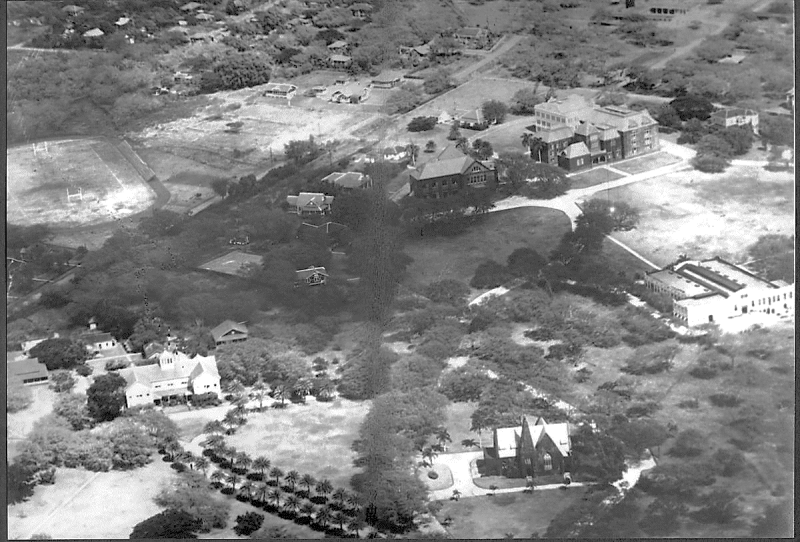
photo courtesy of: Bishop Museum
Aerial photo of the Kaiwiʻula Campus. The largest structure at the top right is the Bishop Museum, and the building to its immediate left is Bishop Hall. At the bottom left is the Preparatory School, with rows of palms lining the main entrance off of King Street. At the bottom right is the Bishop Memorial Chapel, and the large white structure above is the Manual Schoolʻs main building.
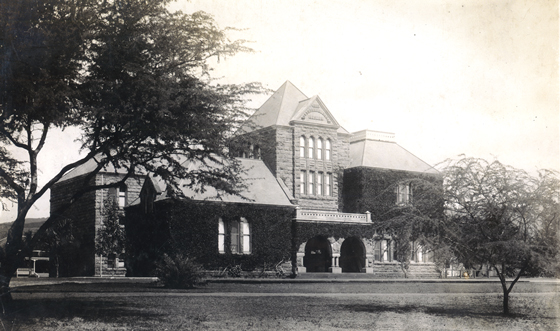
photo courtesy of: Bishop Museum
Bishop Museum, 1889.
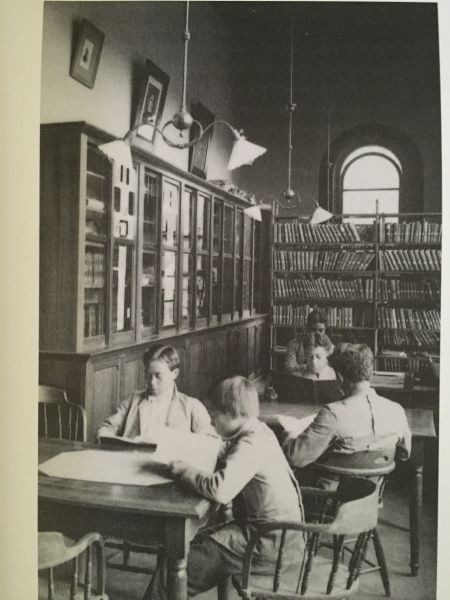
photo courtesy of: Bishop Museum
Bishop Museum Library.
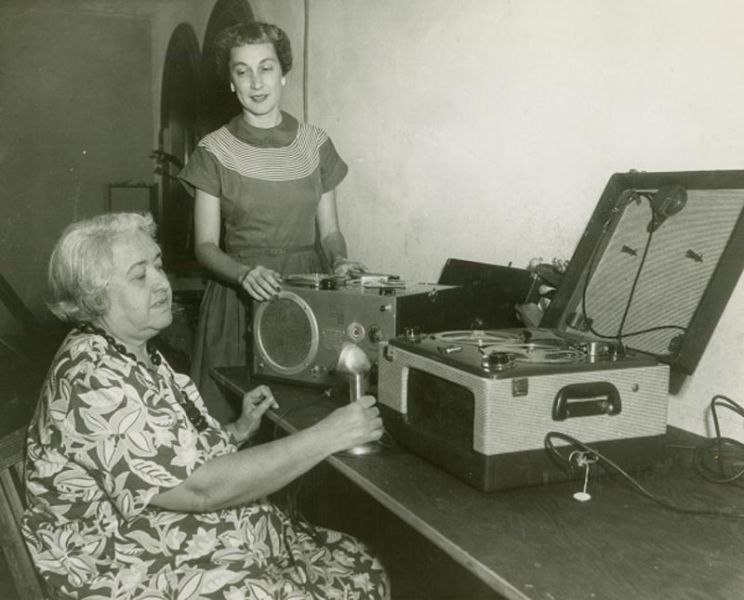
photo courtesy of: Bishop Museum
Mary Kawena Pukui and Dorothy Barrere.
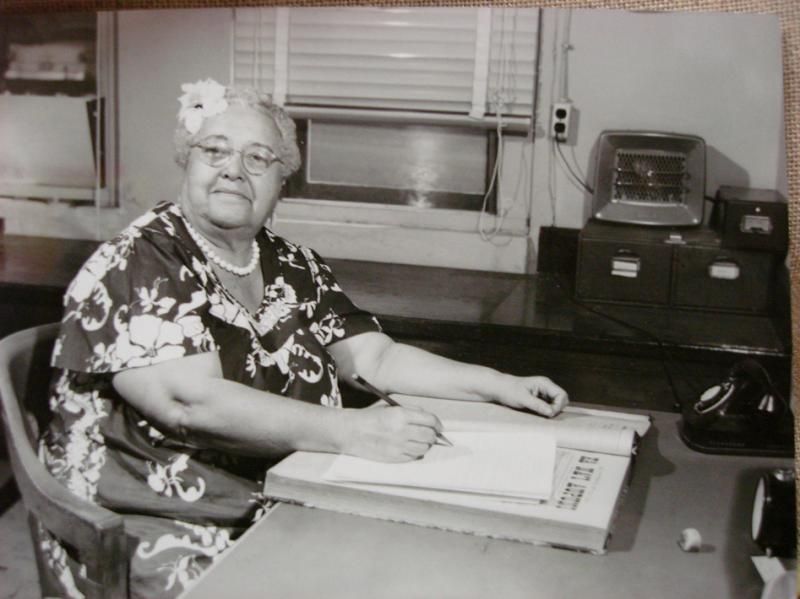
photo courtesy of: Bishop Museum
Mary Kawena Pukui.